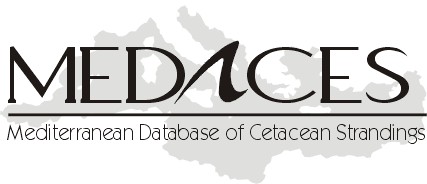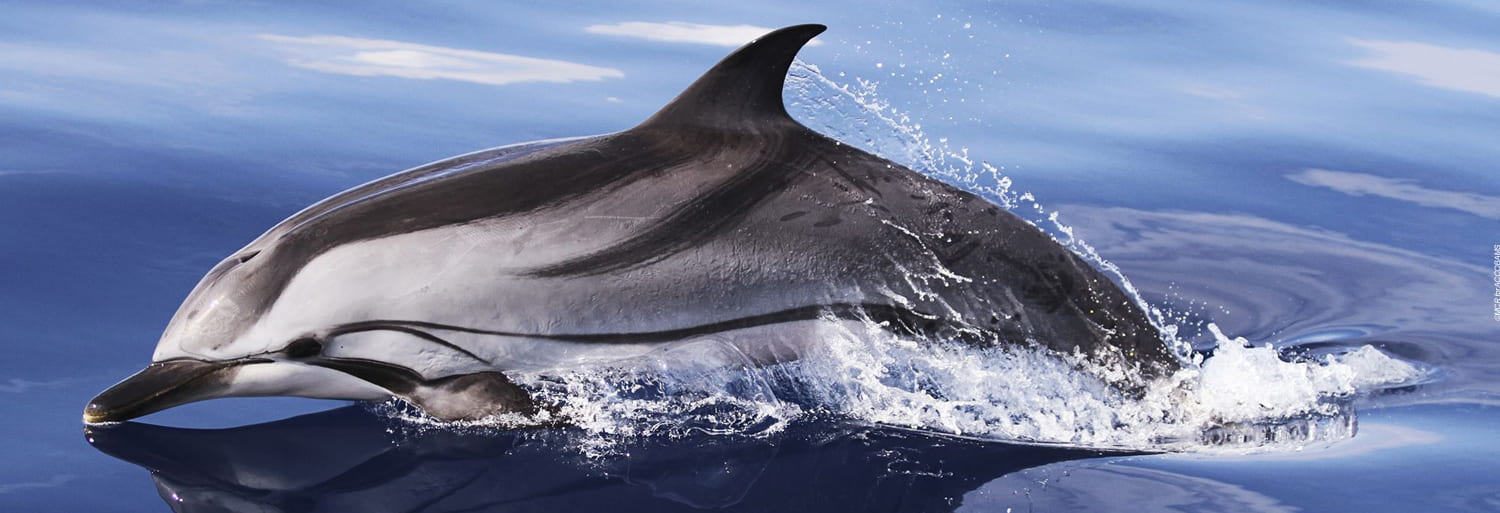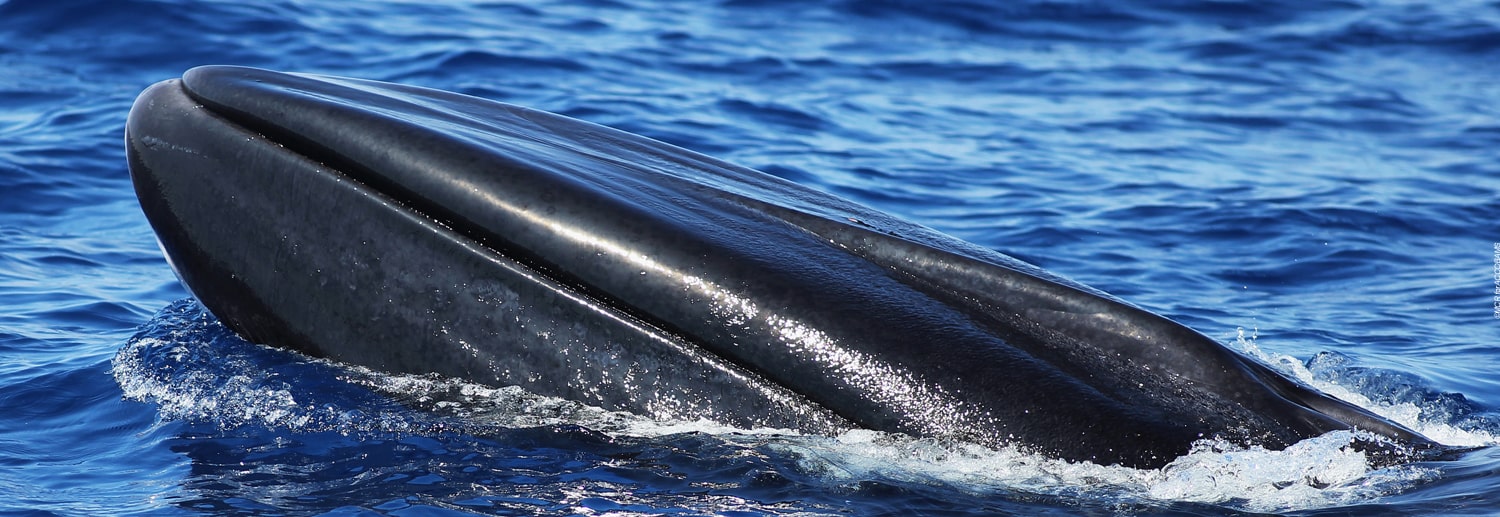Strandings
Literally, a stranded cetacean is one cetacean which body lies entirely on land. The term is used to include both dead and live animals, the latter found in a helpless state after faltering ashore ill, wounded, weak, or simply lost. The term is sometimes expanded to include animals, dead or alive found floating or swimming, respectively, in shallow waters, in the latter case, showing clear signs of physiological dysfunction. Human intervention will not be the same, depending if it is live and dead strandings. Indeed, human intervention in a live stranding may prevent death, or hasten it to prevent suffering. Moreover, on the basis of the number of animals involved, it is possible to distinguish between single and mass strandings.
In order to quantify and explain causes of stranding (natural causes, diseases, human activities), it is necessary to perform systematically postmortem examination of cetaceans found stranded on the coast. These procedures should be carried out through a shared approach in order to compare and exchange data collected during necropsies.
These data provide a better vision of the cetacean populations in the ACCOBAMS zone, a better knowledge of their ecology (biological, genetic data, …) and a better evaluation of the threats facing these species.
Transboundary strandings
Marine mammal strandings can sometimes involve national governments around the globe with specific challenges, in particular when they become a transboundary event. They can affect multiple jurisdictions, involve various policy sectors and require a rapid response, which must be delivered under conditions of media and social pressures. Due to this peculiar and emotive attention, cetacean strandings often become a crisis situation, in particular during alive or mass strandings and those related to epidemic or anthropic causes.
Thus, the organization of an effective response to crisis is fundamental. To face the extraordinary effort that marine mammal strandings can require in specific areas, organizational pattern will have to mobilize different national services and institutions. Rapid support, participation and cooperation from different stakeholders and within scientific organization are requested to ensure an effective response and an adequate coordination of people who have never worked together before. It may be really difficult to reach a good level of coordination under these possible conditions of uncertainty, urgency and stress and maybe without a clear chain of command or hierarchy.
Mediterranean Database of Cetacean Strandings (MEDACES)
The rationale of a databank related with Cetaceans strandings relies in the Agreement text and, more precisely, in the Conservation Plan which ask to:
- develop “systematic research programmes on dead, stranded, wounded or sick animals, to determine the main interactions with human activities and to identify present and potential threats”;
- “develop the systems for collecting data on observations, by-catches, strandings, epizootics and other phenomena related to cetaceans “ ;
- “establish, as appropriate, a sub-regional or regional data bank for the storage of information collected”.
 In November 2001, the 12th Ordinary Meeting of the Contracting Parties to the Barcelona Convention, approved the offer by Spain with regard to the establishment in Valencia of a Mediterranean database on cetacean strandings (MEDACES), within the “SPA/Biodiversity” Protocol. The Regional Activity Centre for Specially Protected Areas (SPA/RAC) is the depositary for the database, whose management is entrusted to the University of Valencia’s Cavanilles Biodiversity Institute (ICBIBE), with the financial support of the Spanish Ministry of Environment (MMA).
In November 2001, the 12th Ordinary Meeting of the Contracting Parties to the Barcelona Convention, approved the offer by Spain with regard to the establishment in Valencia of a Mediterranean database on cetacean strandings (MEDACES), within the “SPA/Biodiversity” Protocol. The Regional Activity Centre for Specially Protected Areas (SPA/RAC) is the depositary for the database, whose management is entrusted to the University of Valencia’s Cavanilles Biodiversity Institute (ICBIBE), with the financial support of the Spanish Ministry of Environment (MMA).
The Mediterranean Database of Cetaceans Stranding has been expanded to cover regions adjacent to the Mediterranean (the Black Sea and the contiguous Atlantic waters) as defined in the Agreement on the Conservation of Cetaceans of the Black Sea, Mediterranean Sea and contiguous Atlantic area (ACCOBAMS).
In this context, since 2010, ACCOBAMS regularly supports financially the continuity of MEDACES. Moreover, at each meeting of the ACCOBAMS Parties this topic has been on the agenda, in particular to encourage scientists to upload their data and to use MEDACES.
During the Sixth Meeting of the Parties to ACCOBAMS (22-25 November 2016, Monaco), a review of the functioning of MEDACES, undertaken by an expert jointly agreed by the ACCOBAMS Permanent Secretariat and the RAC/SPA, was presented. Among these recommendations of this document, it was suggested to assure the continuity of MEDACES for the triennium 2017-2019.
Relevant Resolutions & Reports
ACCOBAMS-MOP1/2002/Res1.10 – Cooperation between National Networks of Cetacean Strandings & Creation of a Database
ACCOBAMS-MOP2/2004/Res2.10 – Facilitation of Exchange of Tissue Samples
ACCOBAMS-MOP3/2007/Res3.25 – Cetacean Live Stranding
ACCOBAMS-MOP4/2010/Res4.16 – Guidelines for a Coordinated Cetacean Stranding Response
ACCOBAMS-MOP6/2016/Res6.22 – Cetacean Live Stranding
ACCOBAMS-MOP7/2019/Res7.14 – Best practices in monitoring and management of cetacean stranding
ACCOBAMS-MOP8/2022/Res8.15 – Cetacean Stranding Networks
Report on the ACCOBAMS/Pelagos Workshop on Cetacean Live Stranding (Monaco, 29-30 October 2014)
ACCOBAMS-MOP6/2016/Inf27: Review of the functioning of MEDACES
ACCOBAMS-MOP7/2019/Doc33: Best practice on cetacean post mortem investigation and tissue sampling (joint ACCOBAMS and ASCOBANS document)
Link to the IWC: Stranded Cetaceans (whales, dolphins and porpoises)





